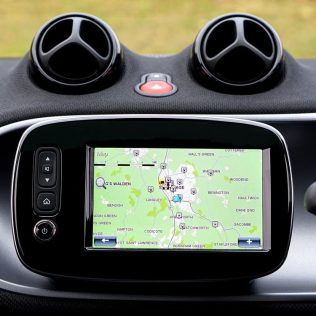When they were introduced, navigation systems were a fancy, expensive feature reserved for luxury, high-end cars. Though now it is common to see this feature even in the most basic models. Even if the car model does not come fitted with one, it is easy to buy a standalone navigation system for cars.
Understanding what is a navigation system
The terms GPS and Sat Nav are often used interchangeably when talking about navigation systems. However, there is a difference between them. GPS (Global Positioning System) refers to a group of about 30 satellites placed around our planet Earth. This system of satellites is owned by the United States government and operated by the United States Space Force, however it has been made publicly available. This network of satellites sends signals to GPS receivers on ground to pinpoint their location, which is provided as coordinates. Satellite navigation software, or Sat nav, prepares a map/route to your destination by combining the coordinates from the GPS signal with a comprehensive map. Some popular brands using GPS and sat nav are TomTom and Garmin.
Is it worth paying extra for a navigation system in rentals?
Whatever car model may you book as a rental, almost all rental companies give you an option to include a navigation system. Despite their wide-spread use, people often wonder whether it is worth paying extra for a navigation system in a car. Especially as people can access GPS navigation and maps via different apps on their phones or other smart devices. If you are renting a car it usually means you do not regularly drive so might be unfamiliar with some routes and/or you are planning a road trip, which means driving in a new, relatively unknown area. Especially if you are going on a long-distance drive or a camping trip, having a reliable navigation system would be very helpful. Some benefits of using a standalone navigation system:
- It offers more advanced route guidance and routing options than the apps available on smartphones
- They have an internal GPS receiver and thus, do not require an internet connection, which could be tricky to have. Especially when you are going on long drives, camping trips, or to spots like wildlife reserves, it can be difficult to get good or any internet connection.
- Even if the area you are going to receives good, constant cellular signal, you might have to pay roaming fees.
- Another drawback of using GPS on your phone is the battery drain. Keeping the GPS on and running the navigation map can drain the battery very quickly. You have to make sure to buy and pack a car charger or portable power bank for your phone.
- Using or handling a phone while driving can be dangerous and is against the law! A car navigation system is much safer to use.
Use it right
Once you select the right model for you, it is still very important to use it right to get the best results. Here are a few things to keep in mind while using navigation systems:
- You have to set the correct destination: be careful about the destination you enter in the system. There are often multiple places with very similar names, so be very precise about the address you set in your navigator.
- Make sure the route is not taking you through some geographical oddity: Though the extensive system of satellites is quite precise and most of the latest navigation systems are very intuitive and constantly update their data/routes, but it is still a machine. Always review the map before starting on a journey. Do a quick research and check that the route is feasible and not asking you to go through any undriveable segments.
- Make sure you didn’t, accidentally or intentionally, “turn off” the internal GPS on the system
